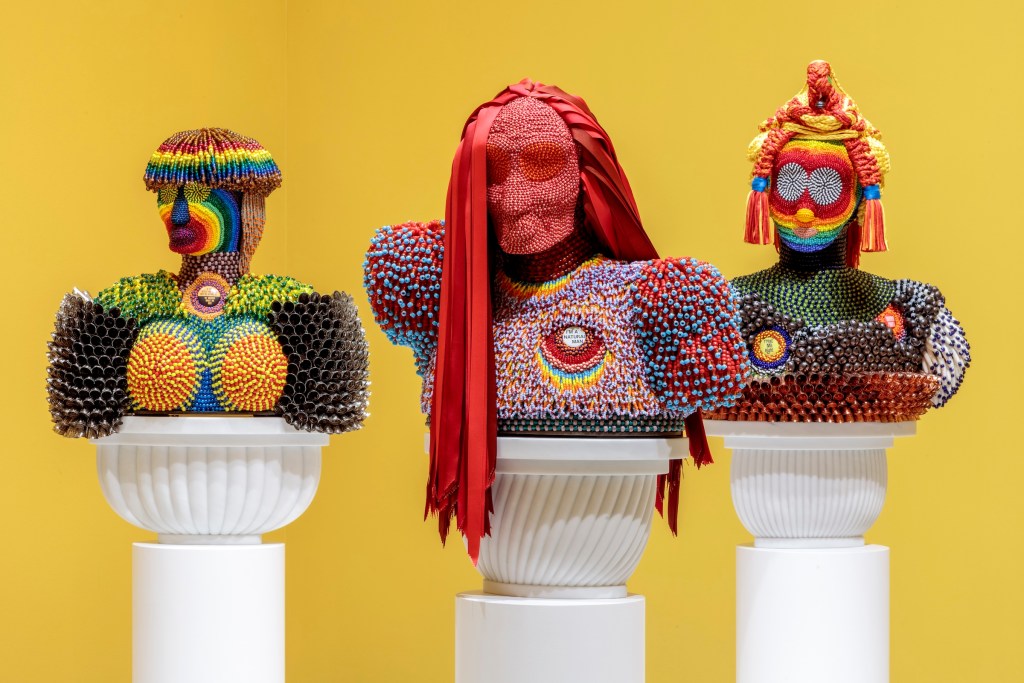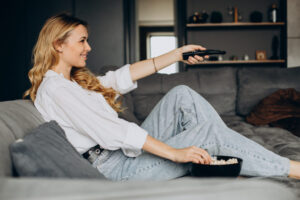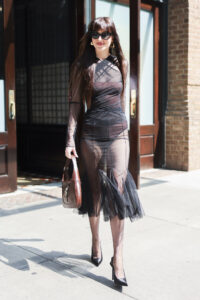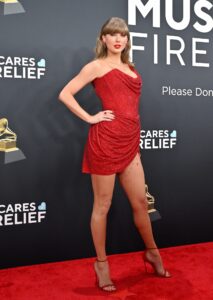15 Art Shows to See in Los Angeles This Summer


This summer, Los Angeles art institutions offer both sorely needed aesthetic escapes and deep dives into contemporary issues. There are several career-ranging surveys and historical reassessments, for one, including a look at Barbara T. Smith’s early Xerox work made on a rented copy machine in her living room; an exhibition at the Hammer covering the brief but brilliant career of late painter Noah Davis; and a Nancy Buchanan retrospective highlighting her multifaceted art practice alongside her commitment to education and collaboration. New work by Jeffrey Gibson at the Broad, Will Rawls at the ICA LA, and Karl Haendel at the Weisman Museum confront various dominant narratives, offering inclusive and disruptive multiplicities of voices. Meanwhile, two very different shows illustrate the role of art to speak to urgent needs and current events: a group exhibition at the California African American Museum focused on the legacy of Altadena’s Black community and its collective loss as a result of the recent Eaton Fire, and a Skirball show dedicated to comic-book artist Jack Kirby, who broadened the medium to address real-world challenges outside of its fantastical storylines. Collectively, these exhibitions underscore the role of the museum as both cultural refuge and community resource.
Barbara T. Smith: Xerox 914
Marciano Art Foundation, 4357 Wilshire Boulevard, Mid-Wilshire, Los Angeles
Through July 5

At 94 years old, Barbara T. Smith is a pioneering figure in West Coast performance art whose multi-disciplinary practice is defined by experimentation, incorporating painting, installation, video, and the early internet. In 1966, before garnering recognition for her performance works, she leased a Xerox 914 photocopier and placed it in the dining room of her Pasadena home. Over the course of eight months, she created thousands of reproductions by copying family photos, autobiographical ephemera, and her nude body, which she laid directly onto the machine’s glass plate. The resulting works — which range from two-dimensional prints to sculptural constructions and artists’ books — engage with seriality, technology, independent publishing, and feminist art, all with an air of expansive curiosity that is evident throughout her six-decade (and counting) career.
Mother Me Meanly
Chez Max et Dorothea, 2228 West 7th Street, Westlake, Los Angeles
Through July 12

Binary conceptions of mothers as either “good” or “bad” aren’t just limited to fairytales. But by contending with the complexities and contradictions of motherhood, Mother Me Meanly counters this false dichotomy. Curated by Lauren Guilford and Shana Hoehn, the exhibition features an intergenerational group of artists who reflect the nurturing, traumatic, generous, and transformative aspects of the maternal spectrum. Highlights include Alison Saar’s haunting sculpture “Milk Teeth” (2021) depicting a figure gnawing on a child’s wooden chair, an image from Ron Athey’s body-modified metamorphosis into the “Venus of Willendorf” (2024), and Dorothea Tanning’s delicate 1965 and ’68 watercolors in which friezes of organic forms vigorously writhe and twist.
Carole Caroompas: Heathcliff and the Femme Fatale Go on Tour
Laguna Art Museum, 307 Cliff Drive, Laguna Beach, California
Through July 13

Carole Caroompas, who died in 2022, was known for her exuberant, layered canvases, in which she pulled from literature, pop culture, and the annals of history to subvert gender, power, and aesthetic hierarchies. Her series Heathcliff and the Femme Fatale Go on Tour (1997-2001) reimagines Emily Brontë’s 1847 novel Wuthering Heights as a rock ‘n’ roll road trip through media-soaked Americana, pairing the book’s male protagonist, Heathcliff, with the titular “Femme Fatale.” Characterized by deep research, technical mastery, and an abrasive punk sensibility, Caroompas’s work did not fit neatly into art historical categories, and she is only now receiving deserved recognition.
Karl Haendel: Less Bad
Frederick R. Weisman Museum of Art, Pepperdine University, 24255 Pacific Coast Highway, Malibu, California
Through July 27

Karl Haendel’s mesmerizing, photo-realistic drawings are situated within a conceptual framework that investigates notions of masculinity, artistic labor, and the function of images in contemporary society. Organized in collaboration with the Kimball Art Center in Park City, Utah, Less Bad features work from the past two decades that draws on art history, mass media, literature, and the artist’s own life, mixing technical mastery with dry wit. The exhibition layout itself highlights playful juxtapositions, allowing viewers to make their own connections between Haendel’s disparate renderings of image and text.
Imagining Black Diasporas: 21st-Century Art and Poetics
Los Angeles County Museum of Art, 5905 Wilshire Boulevard, Mid-Wilshire, Los Angeles
Through July 27

With work by 60 artists from Africa, Europe, and the Americas, and a special focus on those based on the West Coast, Imagining Black Diasporas takes an expansive view of contemporary Black art. Curator Dhyandra Lawson brings together the work of established artists, including Lorna Simpson, Kara Walker, and Glenn Ligon, with that of emerging artists and those likely lesser known to American audiences, such as Ibrahim Mahama and Grace Ndiritu. Imagining Black Diasporas showcases the breadth of Pan-African expressions of displacement, resilience, fusion, and reinvention.
Will Rawls: [siccer]
Institute of Contemporary Art, Los Angeles, 1717 East 7th Street, Downtown, Los Angeles
Through August 31

Taking its name from the Latin “sic” which designates an error in a quotation, Will Rawls’s multi-media installation investigates the way that Black people’s bodies have been scrutinized, erased, and vilified in both cinema and society at large. Employing dance, stop-motion, and audio, the production features an all-Black cast whose movements are set against green backgrounds referencing the green screens used in film to make objects, or people, vanish. [siccer] calls into question subjective attributions of right and wrong, embracing instead the swamplands of indeterminacy.
Noah Davis
Hammer Museum, 10899 Wilshire Boulevard, Westwood, Los Angeles
June 8–August 31

In his brief career, the late artist Noah Davis established himself as a significant voice in contemporary American painting, who was able to impart a sense of gravitas and intimacy to scenes of the everyday. Drawing on a range of visual source material, including found photographs, family archives, and media images, Davis’s paintings reflect a thematic diversity, from African-American history and representation to contemporary culture and mythological narratives. This first institutional survey of his work includes more than 50 paintings created between 2007 and 2015, the year he passed away from a rare form of cancer at the age of 32.
Francis Picabia: Femmes
Michael Werner Gallery, 417 North Camden Drive, Beverly Hills, California
Through August

Francis Picabia is now associated primarily with the Dada movement, but he was something of a modernist chameleon, experimenting with Impressionism, Pointillism, Cubism, and later Surrealism, which he turned to after denouncing Dada in 1921. Femmes spans the 1920s to ’50s, the last three decades of this shape-shifting artist’s life, showcasing his constant reinvention by focusing on one subject: women. The exhibition includes examples from his frantic, dense Monster paintings of the mid-1920s, his ethereal, layered Transparencies series from the end of the same decade, and later works that appropriated pin-up images from 1950s pop culture.
Truthfully, Nancy Buchanan
The Brick, 518 North Western Avenue, East Hollywood, Los Angeles
June 22–September 20

Truthfully, Nancy Buchanan is the first full-career retrospective of this influential LA-based artist, covering her wide-ranging practice of performance, video, digital art, collage, and installation, as well as her long-time role as an educator at the California Institute of the Arts. Organized by Catherine Taft and artist Laura Owens, Buchanan’s former student, the exhibition showcases her experiments with nascent technologies, performance documentation from the 1970s and ’80s, and her often-overlooked lifelong drawing practice, and will feature a realization of her 1973 conceptual work “Hair Room” as well as a new collaboration between Buchanan and Owens. Accompanying programs include video screenings, an event co-presented with the Performance Art Museum, and a restaging of Buchanan’s 1974 performance work “Rock ’n’ Roll” by Slauson Malone 1 (Jasper Marsalis) on the last day of the exhibition.
Jeffrey Gibson: the space in which to place me
The Broad, 221 South Grand Avenue, Downtown, Los Angeles
Through September 28

Choctaw/Cherokee artist Jeffrey Gibson’s dazzlingly vibrant works are both celebratory and mournful, melding Indigenous art traditions, geometric abstraction, and narratives of oppression and resistance. First presented last year at the 60th Venice Biennale, where Gibson was the first Indigenous solo artist to represent the United States, the space in which to place me includes painted and beaded wall works and sculptures featuring excepts from legal texts, quotes, and song lyrics referring to America’s history of racism and repression, as well as the perseverance and solidarity among people of color and LGBTQ+ communities. Not to be missed is the electrifying video “She Never Dances Alone” (2019), in which Sarah Ortegon HighWalking (Eastern Shoshone and Northern Arapaho) performs traditional jingle dancing set to a thumping soundtrack by First Nations musical group the Halluci Nation, an ebullient assertion of this once-banned art form.
Luchita Hurtado: Yo Soy
Hauser & Wirth, 901 East 3rd Street, Downtown, Los Angeles
June 29–October 5

Yo Soy presents works from a crucial period in the prolific career of the late Venezuelan-born, LA-based artist Luchita Hurtado. The exhibition is centered around Hurtado’s 1974 solo show at the Woman’s Building, a historically significant feminist arts space and gallery in LA, which featured her Linear Language series (1972–74). Hurtado began by painting words and phrases onto canvases, which she then cut up and restitched to obscure the text but create luminous, vibrating geometric abstractions in the process. Accompanying these paintings, many of which have never been exhibited before, will be archival material including documentation and ephemera from the Woman’s Building, cooperatively run Womanspace Gallery, and the Los Angeles Council of Women Artists, of which Hurtado was a founding member.
Ode to ’Dena: Black Artistic Legacies of Altadena
California African American Museum, 600 State Drive, Exposition Park, Los Angeles
Through October 12

The horrific wildfires that swept through part of Los Angeles earlier this year were especially devastating to the community of Altadena in Northeast LA, which lost nearly 10,000 structures — 6,000 of those homes — to the Eaton Fire. Altadena is characterized by an especially racially diverse population, with a significant Black community anchored by multigenerational families who have lived there for decades. Ode to ’Dena pays tribute to this community, including scores of Black artists who have called the area home, by recognizing the tragedy of the current moment as well as the potential for rebirth. Curated by Dominique Clayton, founder of Dominique Gallery, the show features work by Sula Bermúdez-Silverman, Kenturah Davis, Mark Steven Greenfield, Dominique Moody, John Outterbridge, Martine Syms, Charles White, and many more.
Black Cowboys: An American Story
Autry Museum of the American West, 4700 Western Heritage Way, Griffith Park, Los Angeles
June 14–January 4, 2026

Black Cowboys: An American Story offers a corrective to the historical erasure of African-American communities in the American West, featuring objects, ephemera, photography, and video that set the record straight, and highlight how the Black cowboy tradition is still alive and well. Originally organized by the Witte Museum in San Antonio, Texas, the Autry’s staging of the exhibition adds a section on California, with figures like Charlie Sampson, the first African-American person to win a world championship in professional rodeo; Black calvary troops known as Buffalo Soldiers; and cinematic portrayals from The Bull-Dogger (1922) to The Harder They Fall (2021).
MOCA Focus: Takako Yamaguchi
Museum of Contemporary Art, 250 South Grand Avenue, Downtown, Los Angeles
June 29–March 1, 2026

Takako Yamaguchi’s enigmatic paintings draw on a multiplicity of sources, including Japanese nihonga paintings, Art Nouveau patterns, European Renaissance motifs, and hard-edge abstraction. She has been mining this postmodern vein since the early 1970s when she moved from Japan to the US, where she has lived ever since. This exhibition, which marks the artist’s first solo US museum show, is part of the MOCA Focus series and highlights new work, introducing the latest developments in her fruitful appropriative strategies.
Jack Kirby: Heroes and Humanity
Skirball Cultural Center, 2701 North Sepulveda Boulevard, Brentwood, Los Angeles
Through March 1, 2026

Late artist Jack Kirby had a hand in creating some of the most iconic comic-book characters of all time: Captain America, the Fantastic Four, the X-Men, Black Panther, and more. He expanded the idea of what comic books could be and the stories they could tell, grappling with current issues of the day such as social justice, representation, and war within visionary narratives. Heroes and Humanity traces his six-decade career, from his childhood as a first-generation Jewish American kid named Jacob Kurtzberg growing up on New York’s Lower East Side in the 1920s and ’30s to his prominent creative roles at both Marvel and DC, as well as the posthumous film adaptations of his work that carry his legacy forward.






